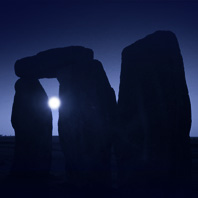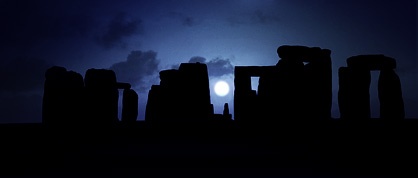The full moon above Stonehenge

Everyone is familiar with the silhouette of the Stonehenge rocks in the southern English county of Wiltshire, one of the truly ancient structures of human kind that continues to fascinate because of its archaic construction and mystical presence. Maybe it reminds us people of our origin and of something we often tend to forget amid our hectic everyday world: simplicity.
At the same time, the building of Stonehenge has been everything but easy back then. The age of the grounds is estimated to be more than 5000 years. Experts assume, it took many millions of working hours to dress and transport the up to 50 tons heavy rocks by hand and to erect them in the well-known formation. In particular the lintels, on top of the upright stones, leave us in awe.
Today, we know about the purpose of the Stonehenge rocks, that they were part of a burial ground and therefore have probably been used for ritual and religious intent. That is why it is referred to a place of ritual worship.
It is further presumed, the formation and position of the stones have an astronomical connection. To mention the orientation to the summer solstice, which could have made Stonehenge to some sort of calendar and could have been used for planning of agricultural activities in this way. Also, the aspect of the moon cycle and prediction of lunar eclipses are relevant topics for discussion, however, science is more or less still groping in the dark. If this should be the case, that lunar eclipses were observed via glimpses through the relevant stones, then the full moon was certainly playing an active part, as lunar eclipses always take place during the full moon.

And even nothing certain can be written about the Moon and Stonehenge, it is definitely safe to say that the people back then were observing the course of the stars and the Moon just like today. And they would have – just like us – experienced the full moon as a special event.

iNTERESTING READ AND i DID NOT KNOW (OR HAD FORGOTTEN) THAT LUNAR ECLIPSES ARE ALWAYS ON A FULL MOON